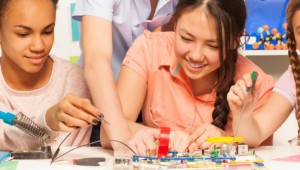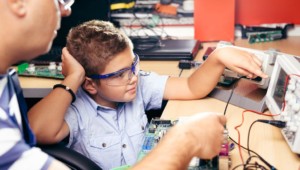How to Teach STEM Without Being an Engineer

Does STEM scare you? I know it scared me. When I was a kid, I watched my brother take apart an entire computer and put it back together without a manual or guide.
Me, I could barely change a lightbulb. And no matter how hard I tried, I always seemed to put IKEA furniture together backward. You should see my bookcase. Very embarrassing.
It was with this same trepidation and insecurity that I approached STEM. What could I teach kids? I’m not an engineer! I’m not a scientist! I’m not a mathematician!
It wasn’t until I reluctantly volunteered to help out with a robotics after school program that I started gaining confidence. I put together my first robot (with a lot of help, TLC from the co-instructor, and even guidance from some eight-year-old kids) and its been downhill from there.
I soon realized that leading successful STEM experiences has less to do with your actual knowledge as an instructor (though it helps), and more to do with the MINDSET you take with kids.
Here are the five MAKER mindsets and how YOU can develop them starting tomorrow.
Mindset #1: Maintain Curiosity
The best STEM teachers are curious. They learn alongside their students. They are just as surprised as to what will happen when you wrap copper wire around a stack of magnets as their kids.
Connection to Practice: Work with some very capable students to try out STEM projects first. Create an inquiry wall for questions along the way. Model thinking routines.
Mindset #2: Always Celebrates
The effective maker constantly celebrates. While they make thousands of mistakes, they know that each one brings them closer to success. Therefore, they celebrate not only their success but also their failure!
Here’s a cute video to illustrate that principle.
Connection to Practice: How often do you celebrate learning? Do you have a tv display or board to showcase student work? Make sure to showcase the process to demonstrate that success takes time and a series of failures is the only pathway to eventual success!
Mindset #3: Keep Going
Inevitably there is going to be lots of frustration when you first start exploring STEM and maker opportunities. You won’t have the right parts. Motors will malfunction. Kids will make a mess—EVERYWHERE. But that’s the fun part.
Case in point—I was working with students on developing a fun circuit “hand game.” The goal is to create light up an LED with a battery, a few wires, and a coat hanger. Seems easy enough right? Wrong. The kids reached a point where they felt like giving up. I stepped in only momentarily and started persisting with them. I asked about all possible combinations. Finally, the LED lit up and so did their faces.
Connection to Practice: How do you build resilience in your students? When students hit roadblocks, do you have a few key phrases or strategies to keep them going? I find a personal story of persistence helps before setting them onto a task. Tell them the story of Benjamin Franklin and the light bulb, or read them a children’s story that illustrates the point.
Maker Mindset #4: Entrust the Process
When asking students to create hydroponic and aquaponic systems, we had no clue what we were doing. None of us teachers had a “green thumb.” In my home, plants usually died within a week—even succulents!
Most of the problem, however, wasn’t in our lack of ability; but rather in the lack of a process to ensure success.
Once we began using a five-step design process with students, it was incredible what they were able to do. In response to a polluted waterway, some students designed bamboo bicycles; others their own eco-friendly upcycled shopping bags; and some, their own toxic free beauty products!
It’s not because these students were better STEM thinkers, but rather because they empathized —> defined the problem —> ideated solutions —> prototyped samples —> and tested on their users. This process helped ensure their final designs were impactful.
Connection to Practice: Have you established routines, systems and processes for your STEM/makerspace? Are students familiar with these processes? Have you modeled them?
Develop a solid design process before tackling any challenge. I like the Stanford D Design Cycle, but there are several more including the MYP Design Cycle and the NGSS cycle.
Maker Mindset #5: Be Ready to “Let Go”
A while back I bought a brand new 3-d printer that sat in its box for most of the year. The reason: I didn’t know how to assemble it. Students asked at least three times a week when they would be able to use it. Rather than let go and let them assemble it themselves, I stubbornly insisted I know everything about it before it came out of the box.
Finally, I caved in.
The students had the thing assembled in 30 minutes flat.
Connection to Practice: Do you have a hard time letting go? What scares you? How might you involve your students more in the process of designing and carrying out STEM challenges?
Letting go is scary. It means we risk feeling a bit out of control. But think about it for a minute. What’s the worst that can happen? A bit of chaos? Loud voices? Students off task? Guess what—that’s all part of learning. To ease your mind, begin each STEM challenge with a discussion of the ‘ground rules/ agreements.’ These can include things like appropriate volume, the inclusion of others, guidelines for computer use, etc.
Establishing this structure will actually increase your ability to ‘let go’ and provide students the freedom they need to be successful.
Want to Deepen Your Learning?
Fortunately, there are more than enough resources to build your confidence as a STEM project designer. Attend a Maker Faire in your area to gather inspiration. Get some inspiration form the PBS Design Squad, who exposes you to exciting design challenges for students to explore. Join the #STEMchat on Twitter and start gathering ideas from other practitioners.
Most of all, don’t be afraid to get started. I promise it gets easier as you go.
P.S. Enjoy the video here of the STEM game I created last week with kids (thanks SSIS). I call it “SURGEON’S SCALPEL.”
For more, see:
- How Maker Education Supports English Languages Learners in STEM
- All About STEM High Schools
- Odyssey STEM: First to Combine Big Picture Learning and altSchool
Stay in-the-know with all things edtech and innovations in learning by signing up to receive our weekly newsletter, Smart Update.






0 Comments
Leave a Comment
Your email address will not be published. All fields are required.